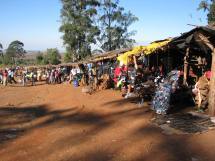Modern Day Slaves to Our Societies Development
I was driving down Linda Road in Lusaka, Zambia when I noticed about thirty shirtless men digging a trench to lay some wires or pipe. They each held their digging tools firmly over their head and in unison swung to the dirt. They continued this motion over and over, each time forming more sweat.
Standing on the outside of the trench, with his hands folded, wearing a wide sun brimmed hat, staring at the men work, was the middle aged supervisor. He was of Asian descent, and did not appear eager to help, but quick to jump in and yell when things weren’t going right.
The image stuck w ith me for several weeks after I noticed the scene. I spent many hours thinking about it, analyzing every moment, trying to contemplate the workers and how little they made, and the supervisor and how much he made.
ith me for several weeks after I noticed the scene. I spent many hours thinking about it, analyzing every moment, trying to contemplate the workers and how little they made, and the supervisor and how much he made.
I did some research on the effects of poverty and even how this impacts the society’s development. What I found was shocking. The average person living in poverty makes $1.25 per day, or $37.50 per month and a meager $450 per year. Most of our phones cost more than that, which we can get in and out of the store in under 30 minutes. Thirty minutes, and we can spend more money than someone digging ditches for an entire year makes.
In 2005 5.15 billion people lived below the poverty line, making roughly $10 per day. Just 1.31 billion found the good fortune of making enough money to stay above this poverty line. This number has fluctuated slightly over the years, but not enough to make profound impacts on society.
22,000 children die each day due to poverty. These children are the voiceless few that are never heard from. They die in small villages, far removed from the hustle and bustle of the modern day society that their parents helped build, but never experience. These children are the same that have no access to clean water, proper food preparation and refrigeration. These children are the faces of the issues, but are never seen.
 How does this all relate to slaves? Slavery is a term that is associated with beatings, treated people less than human, and white supremacy. The black men that dug the ditches, were not beaten, and had no visible scars, but they were slaves to our development.
How does this all relate to slaves? Slavery is a term that is associated with beatings, treated people less than human, and white supremacy. The black men that dug the ditches, were not beaten, and had no visible scars, but they were slaves to our development.
They dug the ditches to the middle and upper-class homes, which they would never see the fruits of their labor. They made just enough money to have beans and rice every day, but rarely enough to have meat. They made no money to give their children a good education, and break the bleak cycle of depression. They broke their backs, digging a ditch to develop the country, while a foreigner stood watch to ensure that the job was complete. The Asian man did nothing, yet took the credit and the money.
There is another side to slavery that is often forgotten. The white owners and managers of the plantation riding around on their horses, supervising the laborious task of picking cotton. The slaves going home with nothing, just enough food to keep them going. Usually only having one meal a day. White owners taking everything, giving nothing back and nothing to sustain society’s growth.
I am not saying that the workforce in Africa and other developing countries is as bad as slavery, far from it, we have come a long way from those dark days. However, I am drawing the comparison, to shock the reader. Even though we pay the workforce, we only pay them enough to sustain life with a meager meal. How is this different than the plantation owner giving no money, but enough food to sustain life? The modern day workforce in developing countries live in small shacks, while the supervisors live in gated communities far from the people. How is this different than a slave living in a small home on the outskirts of the property, while they see in the distance the large white home?
 The modern day workforce does have the right to education, which slaves did not, and they have the right to quit and find other employment. They also have the right to lawyer and the right to medical treatment. However, their inalienable right to these justices are cut at the knees due to their financial inability to pay for these luxuries. How can their children get a decent education with a classroom full of 50 pupils?
The modern day workforce does have the right to education, which slaves did not, and they have the right to quit and find other employment. They also have the right to lawyer and the right to medical treatment. However, their inalienable right to these justices are cut at the knees due to their financial inability to pay for these luxuries. How can their children get a decent education with a classroom full of 50 pupils?
More is needed to distribute wealth amongst the citizens. More is needed to ensure a high quality education. More is needed to help contribute to economic growth. The answers may not be found in this article, because the solution is far reaching and will take many more years. But I implore people to stop and think about how we spend our money. As a society, we cannot sustain social growth as consumers. We can only make social change by enacting principals in our life, to help solve the problem.
You may not agree with this, but I think we can find a common ground and agree that everyone, in every country, in every corner of the world, has the right to an education and a decent salary.




